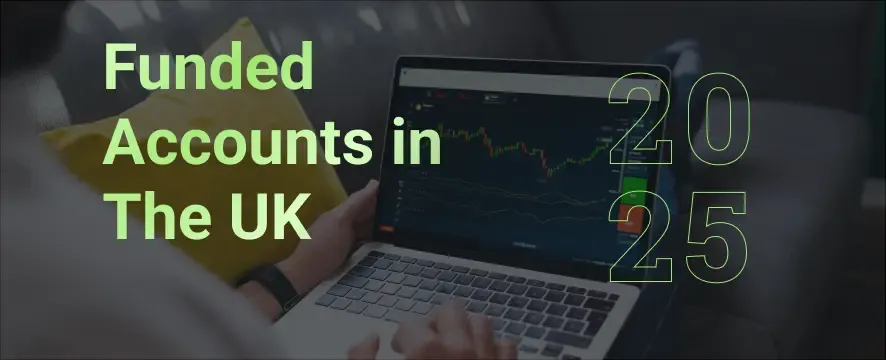11 min read
Share
In this article, we will discuss which are the most volatile currency pairs and how you can effectively trade them.

The forex market draws traders worldwide seeking profits through currency price movements. Although the market can be extremely volatile, this volatility is what helps traders make money.
However, traders aiming to profit through forex volatility must understand which currency pairs offer the greatest potential for significant price swings. While volatile forex pairs can deliver substantial returns, they also present a higher risk of losing money quickly without proper knowledge and risk management.
Volatile Currency Pairs in the Forex Market
Currency pair volatility refers to the rate and magnitude of price changes that specific forex pairs experience.
High volatility means larger, more frequent price movements - creating opportunities for profit but also increasing potential losses.
There are several key factors that influence the volatility of currency pairs:
- Economic data from major economies
- Interest rate differentials between countries
- Political instability in relevant nations
- Market sentiment shifts during global events
- Commodity prices affecting resource-exporting nations
Forex traders use specific tools to measure volatility when evaluating currency pairs. The Average True Range (ATR) indicator is one of the most popular methods. This indicator shows the average trading range over a specified period - and helps identify the most volatile forex pairs by quantifying their typical price movements.
Other traders use Bollinger Band width or historical standard deviation to assess the volatility of currency pairs. Still, other traders simply rely on price action analysis, rather than fancy indicators.
When examining volatile currency pairs, it's important to consider how volatility relates to liquidity. The most traded currency pairs generally offer better liquidity, allowing traders to enter and exit positions efficiently - even during significant price swings.
However, more volatile currency pairs, especially exotic currency pairs, may present wider spreads and make execution different during high volatility.
Major Currency Pairs with Significant Volatility
Among major currency pairs, several stand out for their notable price swings. Here are 3 of the most notable:
EUR/USD:
Despite being the most traded currency, this pair shows moderate volatility compared to other pairs. During major economic events affecting both the UK and European economies, EUR/USD can experience increased volatility. Interest rate announcements from the European Central Bank or Federal Reserve can trigger substantial EUR/USD price movements.
USD/JPY:
This pair represents a major pair with very distinct volatility characteristics. The dollar & Japanese Yen relationship responds strongly to shifts in global risk sentiment, as the Japanese yen serves as a safe-haven currency during market uncertainty. When investors grow nervous about economic conditions, they often purchase yen, creating significant price swings in USD/JPY.
GBP/USD:
Commonly called "Cable," this pair demonstrates substantial volatility, particularly during political developments affecting the British pound. Brexit negotiations drove extreme volatility in this pair, with price swings exceeding normal ranges for major currency pairs. Bank of England policy decisions and UK economic data releases frequently trigger sharp movements in GBP/USD, making it attractive to traders seeking significant price movements within the major currency category.
Commodity Currency Pairs and Their Volatility
There are certain commodity currencies that can display pronounced volatility due to their correlation with raw material prices.
The Australian dollar in AUD/USD pairs can show substantial price movements linked to mineral and metal prices, particularly iron ore and gold. Furthermore, China represents Australia's largest trading partner - hence, Chinese economic data significantly impacts AUD volatility.
The Canadian dollar exhibits strong connections to oil prices, creating significant volatility in USD/CAD. As a major oil exporter, Canada's economic performance closely tracks petrol market fluctuations. When oil prices move sharply, the Canadian dollar typically follows, generating volatile trading conditions.
OPEC announcements, weekly inventory reports, and global energy demand shifts all contribute to USD/CAD volatility, requiring traders to monitor multiple markets simultaneously.
Similarly, the New Zealand dollar (NZD/USD) experiences notable volatility related to agricultural commodity prices, especially dairy products. New Zealand's relatively small economy means its currency responds dramatically to changes in export demand and global risk sentiment.
But remember – these relationships aren't perfect - the correlations can break down during extreme market events.
Exotic Currency Pairs with Extreme Volatility
Exotic pairs involving emerging market currencies usually display the most extreme volatility in forex markets. For example, the USD/MXN pairs the US dollar with the Mexican peso, creating a volatile combination influenced by North American trade relations, political developments, and interest rate differentials.
The Mexican peso's sensitivity to US policy changes makes this pair particularly responsive to U.S. political events and economic announcements.
Another example of a highly volatile currency pair is the USD/TRY, which combines the US dollar with the Turkish lira, demonstrating extraordinary volatility during periods of Turkish economic stress.
This pair can experience single-day movements exceeding 10% during crisis periods, illustrating just how significant price swings in exotic currencies can be.
Other common volatile exotic pairs include the following:
USD/ZAR (US dollar/South African rand) – heavily influenced by gold prices
USD/BRL (US dollar/Brazilian real) – responds dramatically to political developments
EUR/TRY (Euro/Turkish lira) – often shows extreme pip movement during European sessions
USD/RUB (US dollar/Russian ruble) – oil price sensitivity creates massive swings
These combinations frequently experience significant price swings driven by emerging market risk factors, commodity price fluctuations, and political instability.
Although offering potentially larger profit opportunities than major pairs, these exotic combinations come with higher spreads, reduced liquidity, and increased risk of rapid losses during market dislocations.
As with most currencies, it is largely the underlying fundamentals that work together to create volatility.
How to Trade Forex Volatility Effectively
Successfully navigating volatile currency pairs requires a slightly more nuanced approach that balances potential rewards with inherent risks. Here's how to go about trading currency pairs with greater volatility.
Developing Robust Trading Strategies for Volatile Pairs
Effective trading of volatile currency pairs begins with appropriate timeframe selection. While long-term positions face substantial drawdown risk in highly volatile markets, shorter timeframes allow traders to capture price movements while limiting exposure to unexpected reversals.
When trading volatile forex pairs, it's suggested to focus on intraday strategies, using hourly or 15-minute charts for precise entry and exit points.
Technical analysis becomes particularly important when trading volatile pairs. Support and resistance levels can behave differently in high-volatility environments, with prices more likely to break through these 'floors and ceilings' with momentum. When analyzing volatile currency pairs, consider relying on more dynamic indicators like moving averages rather than static levels. Additionally, momentum indicators can be helpful in identifying potential reversal points during significant price swings.
Position sizing is another critical consideration when trading volatile pairs. Standard practice involves using smaller positions than would be appropriate for stable instruments, allowing traders to withstand larger price movements without triggering emotional responses. A more conservative sizing approach, combined with wider stop-loss placement, helps navigate the inherent risks of volatile market conditions while helping to preserve capital.
However, sometimes, the best strategy with super volatile pairs is simply not trading at all - especially if uncertainty and volatility are further heightened.
Managing Risk When Trading Volatile Forex Pairs
Risk management takes on heightened importance when dealing with volatile currency pairs, as significant price swings can quickly transform winning positions into substantial losses. It's important to implement comprehensive risk management strategies, starting with limiting your position size.
A suggested approach is to limit exposure to 0.5-1% of your trading capital per position when trading highly volatile pairs - compared to the 1-2% guideline for stable instruments. This conservative sizing accommodates the larger stop-loss distances typically required for volatile pairs.
Stop-loss placement requires special consideration in volatile markets. More traditional approaches of setting a stop-loss just beyond support and resistance levels often fail with volatile currency pairs, and a different approach - which allows more leeway may be required.
Leverage management represents another crucial risk consideration. Using maximum available leverage when trading volatile pairs dramatically increases the risk of losing money rapidly. It may be wise to reduce leverage when dealing with volatile currency pairs, sometimes using leverage as low as 5:1 - even if you have access to much higher levels. A more conservative approach to leverage helps further preserve capital during unexpected movements that typically characterize volatile markets.
To summarize the most important risk management principles for volatile pairs:
Never risk more than 1% of trading capital
Use appropriate leverage that accounts for rapid price movements
Consider not trading if conditions are unfavorable
Keeping powder dry for high-probability setups rather than overtrading
Set strategic stop-loss orders
Making Informed Trading Decisions in Volatile Markets
Successfully navigating volatile currency pairs depends on making informed decisions based on comprehensive market analysis. This process begins with fundamental awareness, particularly regarding economic indicators that can impact currency valuations.
Traders focused on volatile pairs pay special attention to GDP reports, employment figures, inflation data, and central bank announcements, as these typically generate significant price movements.
Interest rates and central bank policies exert powerful influences on currency pair volatility, and the interplay of monetary policy between countries often drives substantial moves in currency pairs.
Policy surprises from major central banks like the Federal Reserve, European Central Bank, or Bank of Japan can trigger extreme volatility across multiple currency pairs simultaneously.
During periods of heightened global uncertainty, even typically stable currency pairs may experience increased volatility, while already volatile pairs might become too unpredictable for effective trading. Recognizing these sentiment shifts helps determine when to engage with volatile markets and when to remain sidelined.
Therefore, paying attention to the fundamental factors which underpin currency fluctuations is especially important when navigating your way through volatile currency pairs.
Balancing Volatile and Stable Currency Pairs in Trading
When it comes to forex trading, a more balanced approach usually yields the best long-term results. While volatile pairs do offer opportunities for significant profits through dramatic price movements, incorporating some less volatile currency pairs provides stability and consistent trading opportunities.
The least volatile currency pairs typically include EUR/CHF, pairing the euro against the Swiss franc. This combination shows relatively stable trading prices due to the close economic ties between Switzerland and the European Union. Similarly, USD/CHF combines the US dollar with the Swiss franc, creating a more predictable instrument than many other dollar-based pairs.
The Swiss franc's traditional role as a safe-haven currency contributes to these pairs' relative stability, although they also are not immune to dramatic volatility spikes during extreme market conditions.
EUR/GBP represents another relatively stable pair that generally experiences less dramatic price swings than many alternatives. The close geographical and economic relationships between the UK and the European Union create interconnected economic cycles that generally limit extreme divergences.
During periods of global economic stability, it can be more profitable to allocate higher percentages to volatile pairs to maximize returns. Conversely, increasing exposure to stable pairs during uncertain market environments may help preserve capital more effectively.
The Impact of Global Events on Currency Pair Volatility
External factors usually drive significant price movements in forex markets, with certain currency pairs showing particular sensitivity to specific global developments.
Economic growth differentials between countries can create substantial currency pair volatility - particularly when growth trajectories diverge significantly. Traders monitoring volatile forex pairs track comparative GDP figures, manufacturing indices, and other growth measures to identify potential volatility catalysts before they impact market prices.
Central bank policy divergence represents one of the most powerful drivers of currency pair volatility. When major central banks move in opposite directions - one tightening while another eases monetary policy - the resulting interest rate differentials often trigger significant and prolonged currency movements.
Mastering Forex Volatility Through Knowledge and Discipline
Trading volatile currency pairs successfully requires a combination of technical expertise with psychological discipline and comprehensive risk management. Complex instruments like volatile forex pairs demand a thorough understanding before you start trading them actively.
Disciplined execution represents the cornerstone of effective volatile pair trading. Even the most sophisticated strategy can fail without consistent application and emotional control. The significant price movement of volatile forex pairs can trigger psychological responses that compromise trading decisions unless managed through predetermined rules and systematic approaches.
Remember that even the most volatile currency pairs follow certain patterns and respond to identifiable catalysts. By studying these patterns and making informed trading decisions based on comprehensive analysis, you can develop strategies that work effectively in both volatile and stable market conditions.
Also read

16 min read
Discover the essentials of proprietary trading and learn what a prop firm is. Understand the benefits and risks involved. Read the full guide now!

17 min read
Discover essential tips for selecting the right funded trader prop firm to match your trading goals. Read the article to find your perfect trading partner.

13 min read
Discover what a funded account is and how it can benefit UK traders in 2025. Get essential insights and tips to navigate your trading journey. Read more!

13 min read
Discover how funded trading accounts provide access to professional capital without financial risk. Read on to learn more and start your trading journey.

20 min read
Discover what a funded firm is and how prop trading companies operate. Gain insights into their benefits and challenges.
Join our community
Get an insight from other users about SeacrestFunded and their experiences. 131K+ members and counting
